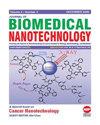微纤维关联蛋白-3-Like 通过 TNFR2/p38 MAPK 通路调控内皮细胞中 TGFβ 诱导的 EMT 过程
IF 2.9
4区 医学
Q1 Medicine
引用次数: 0
摘要
腹主动脉炎(AAI)是一种以慢性炎症和纤维化为特征的主要动脉血管炎。内皮细胞转化为间充质细胞(EMT)是脉管炎纤维化的重要机制之一。尽管EMT在AAI中非常重要,但其分子机制仍鲜为人知。在本研究中,我们通过腹腔注射肿瘤坏死因子-α(TNFα)诱导小鼠AAI。为了分析蛋白质的表达,我们进行了 Western 印迹。此外,我们还使用纳米磁珠法提取了 RNA,以研究功能相关基因的表达。我们使用划痕和 Transwell 技术进行了细胞迁移和侵袭试验。Western 印迹分析显示,微纤维相关蛋白-3-样(MFAP3L)和肿瘤坏死因子(TNF)受体 2(TNFR2)上调,p38 信号通路激活。值得注意的是,MFAP3L 的表达在转化生长因子-β(TGFβ)诱导的内皮细胞 EMT 过程中起着至关重要的作用。此外,我们还发现 MFAP3L 介导的 EMT 依赖于 TNFR2 的表达和 TNFR2/p38 信号通路的活性。本文章由计算机程序翻译,如有差异,请以英文原文为准。
Microfibril-Associated Protein-3-Like Regulates TGFβ-Induced EMT Process via TNFR2/p38 MAPK Pathway in Endothelial Cells
Abdominal aortic inflammation (AAI) is a major arterial vasculitis characterized by chronic inflammation and fibrosis. Endothelial cells transform into mesenchymal cells (EMT) is one of the significant mechanisms of vasculitis fibrosis. Despite its importance, the molecular mechanism
of EMT in AAI remains poorly understood. In this study, we induced AAI in mice through intraperitoneal injection of tumor necrosis factor-alpha (TNFα). To analyze protein expression, we performed Western blotting. Additionally, we extracted RNA using the nanomagnetic bead method
to investigate the expression of functionally related genes. We conducted cell migration and invasion assays using scratch and Transwell techniques. Western blot analysis revealed the upregulation of microfibril-associated protein-3-like (MFAP3L) and tumor necrosis factor (TNF) receptor 2
(TNFR2), along with p38 signaling pathway activation. Notably, MFAP3L expression played a crucial role in the transforming growth factor-beta (TGFβ)-induced EMT process in endothelial cells. Furthermore, we identified that MFAP3L-mediated EMT relied on both TNFR2 expression and
the activity of the TNFR2/p38 signaling pathway.
求助全文
通过发布文献求助,成功后即可免费获取论文全文。
去求助
来源期刊
CiteScore
4.30
自引率
17.20%
发文量
145
审稿时长
2.3 months
期刊介绍:
Information not localized

 求助内容:
求助内容: 应助结果提醒方式:
应助结果提醒方式:


